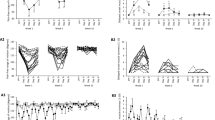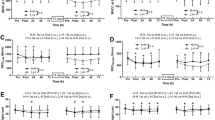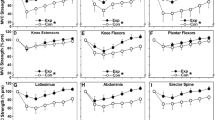Abstract
Purpose
This study compared the exercise induced muscle damage and repeated bout effect after isoload vs isokinetic eccentric supra-maximal single session.
Methods
Thirty sport science male students were randomly divided in isokinetic (IK) and isoload (IL) eccentric training. Creatin kinase (CK) serum activity, muscle soreness and strength decrement measured both in dynamic and isometric modalities were recorded at baseline, immediately after and up to 4 days following 48 supramaximal IK or IL eccentric contractions. Same protocol was repeated after 4 weeks. A three-way repeated measures ANOVA was used to detect differences in dependent variables comparing group × bout × time.
Results
No three-way interaction occurred in dependent variables. Bout × time resulted in a significant interaction in all dependent variables. Muscle damage markers resulted significantly altered compared to baseline up to 4 days. However, IL showed significantly greater CK, muscle soreness and strength deficit compared to IK. All parameters were significantly reduced after second compared to first bout. Difference between IL and IK after second bout was not overall significant.
Conclusion
IK vs IL supra-maximal eccentric contraction is showed to have different muscle damage symptoms. Protection conferred by first bout reduced muscle damage after 4 weeks and decreased difference between IL and IK.










Similar content being viewed by others

References
Nosaka K, Clarkson PM (1995) Muscle damage following repeated bouts of high force eccentric exercise. Med Sci Sports Exerc 27:1263–1269
Chen TC, Nosaka K (2006) Effects of number of eccentric muscle actions on first and second bouts of eccentric exercise of the elbow flexors. J Sci Med Sport 9:57–66. doi:10.1016/j.jsams.2006.03.012
Hubal MJ, Rubinstein SR, Clarkson PM (2007) Mechanisms of variability in strength loss after muscle-lengthening actions. Med Sci Sports Exerc 39:461–468. doi:10.1249/01.mss.0000247007.19127.da
Kostek MC, Chen Y-W, Cuthbertson DJ et al (2007) Gene expression responses over 24 h to lengthening and shortening contractions in human muscle: major changes in CSRP3, MUSTN1, SIX1, and FBXO32. Physiol Genomics 31:42–52. doi:10.1152/physiolgenomics.00151.2006
Chapman DW, Newton M, McGuigan M, Nosaka K (2008) Effect of lengthening contraction velocity on muscle damage of the elbow flexors. Med Sci Sports Exerc 40:926–933. doi:10.1249/MSS.0b013e318168c82d
Clarkson PM, Hubal MJ (2002) Exercise-induced muscle damage in humans. Am J Phys Med Rehabil 81:S52–S69. doi:10.1097/01.PHM.0000029772.45258.43
Nosaka K, Sakamoto K, Newton M, Sacco P (2001) The repeated bout effect of reduced-load eccentric exercise on elbow flexor muscle damage. Eur J Appl Physiol 85:34–40. doi:10.1007/s004210100430
Lavender AP, Nosaka K (2006) Comparison between old and young men for changes in makers of muscle damage following voluntary eccentric exercise of the elbow flexors. Appl Physiol Nutr Metab 31:218–225. doi:10.1139/h05-028
Jamurtas AZ, Theocharis V, Tofas T et al (2005) Comparison between leg and arm eccentric exercises of the same relative intensity on indices of muscle damage. Eur J Appl Physiol 95:179–185. doi:10.1007/s00421-005-1345-0
Chen TC, Chen H-L, Lin M-J et al (2009) Muscle damage responses of the elbow flexors to four maximal eccentric exercise bouts performed every 4 weeks. Eur J Appl Physiol 106:267–275. doi:10.1007/s00421-009-1016-7
Chen TC, Nosaka K, Sacco P (2007) Intensity of eccentric exercise, shift of optimum angle, and the magnitude of repeated-bout effect. J Appl Physiol 102:992–999. doi:10.1152/japplphysiol.00425.2006
Stupka N, Tarnopolsky MA, Yardley NJ, Phillips SM (2001) Cellular adaptation to repeated eccentric exercise-induced muscle damage. J Appl Physiol 91:1669–1678
Smith LL, Fulmer MG, Holbert D et al (1994) The impact of a repeated bout of eccentric exercise on muscular strength, muscle soreness and creatine kinase. Br J Sports Med 28:267–271. doi:10.1136/bjsm.28.4.267
Nosaka K, Sakamoto KEI, Newton M, Sacco P (2001) How long does the protective effect on eccentric exercise induced muscle damage last? Med Sci Sport Exerc 33:1490–1495
Chen TC, Nosaka K (2006) Responses of elbow flexors to two strenous eccentric exercise bouts separated by three days. J Strength Cond Res 20:108–116
Howatson G, Van Someren K, Hortobágyi T (2007) Repeated bout effect after maximal eccentric exercise. Int J Sports Med 28:557–563. doi:10.1055/s-2007-964866
Lavender AP, Nosaka K (2008) A light load eccentric exercise confers protection against a subsequent bout of more demanding eccentric exercise. J Sci Med Sport 11:291–298. doi:10.1016/j.jsams.2007.03.005
McHugh MP, Connolly DA, Eston RG et al (2001) Electromyographic analysis of repeated bouts of eccentric exercise. J Sports Sci 19:163–170. doi:10.1080/026404101750095295
McHugh MP, Tetro DT (2003) Changes in the relationship between joint angle and torque production associated with the repeated bout effect. J Sports Sci 21:927–932. doi:10.1080/0264041031000140400
Chapman DW, Newton MJ, Zainuddin Z et al (2008) Work and peak torque during eccentric exercise do not predict changes in markers of muscle damage. Br J Sports Med 42:585–591. doi:10.1136/bjsm.2007.037929
Howatson G, van Someren KA (2007) Evidence of a contralateral repeated bout effect after maximal eccentric contractions. Eur J Appl Physiol 101:207–214. doi:10.1007/s00421-007-0489-5
Chapman DW, Newton M, McGuigan MR, Nosaka K (2008) Comparison between old and young men for responses to fast velocity maximal lengthening contractions of the elbow flexors. Eur J Appl Physiol 104:531–539. doi:10.1007/s00421-008-0806-7
Guilhem G, Cornu C, Guével A (2011) Muscle architecture and EMG activity changes during isotonic and isokinetic eccentric exercises. Eur J Appl Physiol 111:2723–2733. doi:10.1007/s00421-011-1894-3
Guilhem G, Cornu C, Maffiuletti NA, Guével A (2012) Neuromuscular Adaptations to Isoload versus Isokinetic Eccentric Resistance Training. Med Sci Sports Exerc. doi:10.1249/MSS.0b013e31826e7066
Nosaka K, Newton M, Sacco P (2002) Delayed-onset muscle soreness does not reflect the magnitude of eccentric exercise-induced muscle damage. Scand J Med Sci Sports 12:337–346
Brzycki M (1993) Strength testing—predicting a one-rep max from reps-to-fatigue. J Phisical Edu Recreat Danc 68:88–90
Paddon-Jones D, Keech A, Lonergan A, Abernethy P (2005) Differential expression of muscle damage in humans following acute fast and slow velocity eccentric exercise. J Sci Med Sport 8:255–263
Cleak MJ, Eston RG (1992) Muscle soreness, swelling, stiffness and strength loss after intense eccentric exercise. Br J Sports Med 26:267–272. doi:10.1136/bjsm.26.4.267
Paschalis V, Koutedakis Y, Baltzopoulos V et al (2005) Short vs long length of rectus femoris during eccentric exercise in relation to muscle damage in healthy males. Clin Biomech (Bristol, Avon) 20:617–622. doi:10.1016/j.clinbiomech.2005.02.011
Guilhem G, Guével A, Cornu C (2010) A standardization method to compare isotonic vs. isokinetic eccentric exercises. J Electromyogr Kinesiol 20:1000–1006. doi:10.1016/j.jelekin.2010.03.009
Pincivero DM, Salfetnikov Y, Campy RM, Coelho AJ (2004) Angle- and gender-specific quadriceps femoris muscle recruitment and knee extensor torque. J Biomech 37:1689–1697. doi:10.1016/j.jbiomech.2004.02.005
Chapman D, Newton M, Sacco P, Nosaka K (2006) Greater muscle damage induced by fast versus slow velocity eccentric exercise. Int J Sports Med 27:591–598. doi:10.1055/s-2005-865920
Shepstone TN, Tang JE, Dallaire S et al (2005) Short-term high- vs. low-velocity isokinetic lengthening training results in greater hypertrophy of the elbow flexors in young men. J Appl Physiol 98:1768–1776. doi:10.1152/japplphysiol.01027.2004
Jones DA, Newham DJ, Round JM, Tolfree SE (1986) Experimental human muscle damage: morphological changes in relation to other indices of damage. J Physiol 375:435–448
Jones DA, Newham DJ, Torgan C (1989) Mechanical influences on long-lasting human muscle fatigue and delayed-onset pain. J Physiol 412:415–427
Nosaka K, Clarkson PM (1996) Variability in serum creatine kinase response after eccentric exercise of the elbow flexors. Int J Sports Med 17:120–127. doi:10.1055/s-2007-972819
Kanda K, Sugama K, Sakuma J et al (2014) Evaluation of serum leaking enzymes and investigation into new biomarkers for exercise-induced muscle damage. Exerc Immunol Rev 20:39–54
Paschalis V, Baltzopoulos V, Mougios V et al (2008) Isokinetic eccentric exercise of quadriceps femoris does not affect running economy. J Strength Cond Res 22:1222–1227
Byrne C, Eston RG, Edwards RH (2001) Characteristics of isometric and dynamic strength loss following eccentric exercise-induced muscle damage. Scand J Med Sci Sports 11:134–140
Le Pera D, Graven-Nielsen T, Valeriani M et al (2001) Inhibition of motor system excitability at cortical and spinal level by tonic muscle pain. Clin Neurophysiol 112:1633–1641
Proske U, Weerakkody NS, Percival P et al (2003) Muscle mechanics and energetics : a comparative view force-matching errors after eccentric exercise attributed to muscle soreness. Clin Exp Pharmacol Physiol 30:576–579
Morgan DL (1990) New insights into the behavior of muscle during active lengthening. Biophys J 57:209–221. doi:10.1016/S0006-3495(90)82524-8
Hortobagyi T, Houmard J, Fraser D et al (1998) Normal forces and myofibrillar disruption after repeated eccentric exercise. J Appl Physiol 84:492–498
Pizza FX, Davis BH, Henrickson SD et al (1996) Adaptation to eccentric exercise: effect on CD64 and CD11b/CD18 expression. J Appl Physiol 80:47–55
Acknowledgments
The research was supported by XXIV doctorate cycle fund scholarship, University of Verona.
Conflict of interest
G. Coratella and L. Bertinato declared that they have no conflict of interest.
Human and Animal Rights
All procedures followed were in accordance with the ethical standards of the responsible committee on human experimentation (institutional and national) and with the Helsinki Declaration of 1975, as revised in 2000.
Informed consent
Informed consent was obtained from all patients for being included in the study.
Author information
Authors and Affiliations
Corresponding author
Rights and permissions
About this article
Cite this article
Coratella, G., Bertinato, L. Isoload vs isokinetic eccentric exercise: a direct comparison of exercise-induced muscle damage and repeated bout effect. Sport Sci Health 11, 87–96 (2015). https://doi.org/10.1007/s11332-014-0213-x
Received:
Accepted:
Published:
Issue Date:
DOI: https://doi.org/10.1007/s11332-014-0213-x



